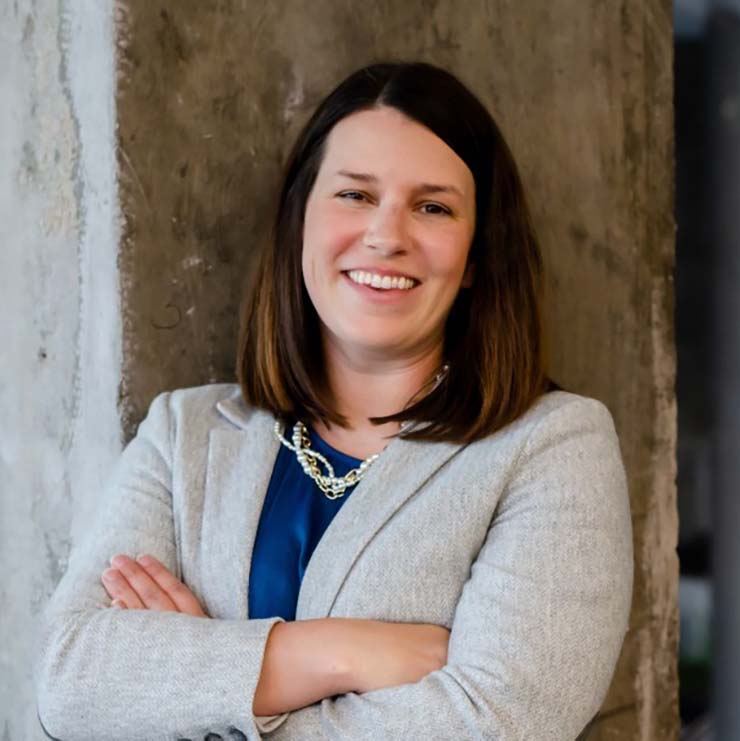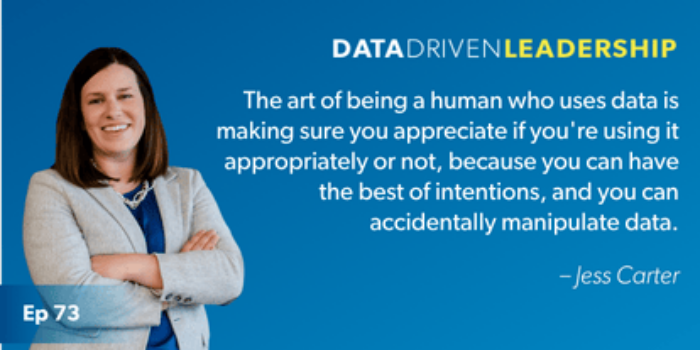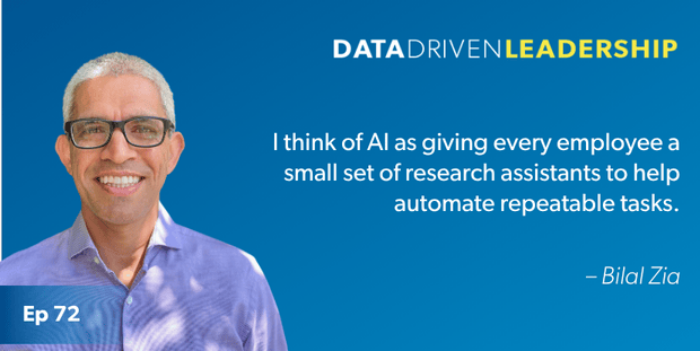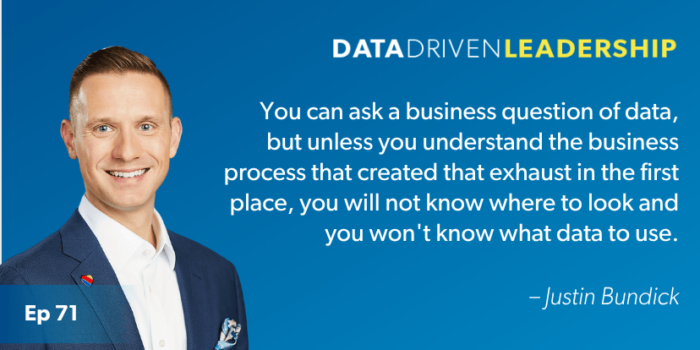

Transcript
Jess Carter: The power of data is undeniable and unharnessed. It's nothing but chaos.
Speaker 2: The amount of data, it was crazy.
Speaker 3: Can I trust it?
Speaker 4: You will waste money.
Speaker 5: Altogether with duct tape.
Speaker 6: Doomed to failure.
Jess Carter: This season, we're solving problems in real time to reveal the art of the possible. Making data your ally. Using it to lead with confidence and clarity, helping communities and people thrive. This is Data Driven Leadership, a show by Resultant. Welcome back to Data Driven Leadership. I'm your host, Jess Carter.
Hey everyone. Welcome back to the show. It's me, Jess, and I've got a different kind of episode for you today. I wanted to spend some time reflecting on the incredible season two that we've had and share some of my last words of wisdom before we take a short break to work on season three. So, I'm not gonna summarize these. I just wanna talk about lessons I've learned from some of these individuals that might be applicable to you, too.
First, Todd Hurst was on a couple of our episodes, and what I really appreciated about him was the way he addressed the situation, that can be really scary. Where you were running a data project and realized that the most important data you could use, or would want to use doesn't exist. And how he pivoted and handled that surrounded by people who really wanted outcomes and people who helped fund it. And I think he did that with sophistication and clarity.
Hannah discussed how to remember that the patient is human first. And I think she talked a lot about the criticality of discernment in leadership development.
Matt Tischler helped us understand if you show up on a new job and data matters and there isn't any, where to begin. How to make some incremental value with that incremental progress around an enterprise data warehouse.
I really enjoyed listening to Arman Petrossian talk about how just chasing his own conviction led to the solution to a problem that generated a whole career for him, and a business. I think his passion is just really inspiring.
Denise Luster and Stephanie Fritz really spent some time talking about the importance of data in nonprofits and how to empower organizations through strategic use of data.
Meanwhile, Amy Pipher and Michael Schmierer also talked about nonprofits and how to see their data as an asset. You don't just have to be a large company with a whole bunch of funding to recognize that the data you already have is really valuable to the organization, and you can use it strategically.
Allison Grayson talked through organizational change management. And again, I think, emphasized that anyone would pay a whole bunch of money if they could have a tool or a widget that just punched out changed behavior in their organization. That is doing organizational change management well. You just need someone who cares enough about how to do that, using the right framework and philosophy for the outcomes that the business intends. It's not simple. It's important.
Christopher Chin helped us understand how anyone listening to this podcast can enhance their presentation skills and better leverage the impact of the data that they're using.
Curt Merlau walked us through where he found himself on a data literacy journey as a teacher all the way to where he is now. And I think it invites a conversation for you to self-reflect with me on where do you find yourself on that data literacy journey. And how can you improve your own data literacy? How you leverage data, what data you ask for, and how you're measuring outcomes.
Chris Hein reviewed and helped unpack a bit about what is Generative AI and how can we leverage that in the future for big, public, complex human problems.
Lastly, Fred Gottman was a masterclass on how to think about your servers strategically and are they in a room or, in a server farm, or on the cloud, and what does it look like for you to maybe think about them as a strategic part of your business and if your business technology needs to change, why, when, and for what outcomes.
This has been such a cool season. I have really enjoyed it.
I'm not gonna pretend that I know everything when it comes to data-driven leadership. I hope you've never gotten that impression from me. But there are a lot of things I've learned over the last nine and a half, ten years, working through projects and conversations with peers and clients that could be useful to you as you navigate within your own role.
So, for today's episode, I'm gonna share some advice for being thoughtful about how you can tell data-driven stories. I don't think it's easy. I think if you wanna do this well, it takes some preparation, but I think you can pick a handful of things and work on those. You don't have to do everything, but I made a quick list, and I thought it could be really helpful for the many people that are asking, um, kinda at scale to cover some thoughts I have. So, I will elaborate here a bit, but here are just some, kind of a quick list of things I think are really important.
So, if you think about your next board meeting or maybe the next interview you have and, how do you tell a story about 30 years of your experience that really conveys the right message and is concise and is captivating, right? So everybody's got a story to tell. And if you think about it, you know, they tend to land better. If you do have data to convey that story, it can be an incredible tool. It can also be a lot of noise. Like, if you come to a meeting with just all the data on earth or have your fascination of what you think is interesting, you probably have this moment where you walk out, and you think like, I just don't think that landed, and I don't know why. I have been there, too.
So a lot of these lessons come from my failures more so than my successes, where I walk out and think like man, I am fascinated about something. Why isn't someone else? And it's usually because of how I delivered the story. I'm innately intrigued by what I have to share. They aren't… so, I'm gonna borrow from advice I heard recently from Chris Chin, which is: Know your audience about three times as well as you think you need to.
So I think about when I was, you know, an early manager, and I was working with people before I had kids. I wondered why people got frustrated if I had a quick seven forty-five call to them or an eight o'clock meeting, starting right at, you know when traditional work starts. And then I had kids, and I realized they're trying to get their kids on the bus or dropped off at daycare, and their morning is kind of chaotic. And it was this part of knowing my audience, like the difference between me throwing a meeting on someone's calendar with no heads up or request verbally first compared to me asking for that time, not assuming I had it, was a very different reception from them, and it was a reflection of how little I appreciated what their lives looked like.
So, as I continue to unpack what it looks like to tell a great data story, another topic I wanted to cover is, know what your story is and understand what you're trying to tell.
So, one of the things I struggle with is I try to jampack too many things into one story. So I'll kind of try to make these little minor points. And they're not really part of, they're not a main character. It's okay if you forget them. And what I've learned is, my storytelling gets better if I practice and I identify the mini points I'm trying to make, and I kill them. They're not relevant to this discussion. They don't need to happen now. I'm just trying to jampack one more thing in and my audience can tell. They will get disillusioned by, like, it's distracting. I'm taking them somewhere else when we were headed to the right, and suddenly we're heading to the left.
So, an example of this would be, I did this today. I was talking to someone, we were building a case for change around an upcoming change in our company, and there was an adjacent thing coming up in the company, and I thought it might be good to tee that up here. And I wrote it down and realized it has nothing to do with this change. It's just a different change. And it confuses the change communication I'm trying to make simple and clear. Yes, I'm anticipating future change, and I thought it might be good to try and start to roll out that red carpet now, but I thought about it and deleted it and realized that was going to distract people from the actual outcome I wanted from that communication piece.
So, one of the things that's really important is, I will think about this opportunity, I have a board meeting conversation, a podcast episode, what have you, and it really helps me to center myself around. I'll play through all the ideas of what is the goal and what's the story, but at some point, it has to land. I have to stop and kill all the noise and pick a main character and appreciate the one message I'm trying to send. Maybe I'll circle back and add some other complexities, but I usually lean on overcomplicating something, not simplifying. So that's something else that I work on when it comes to how to tell the right story is: Figure out what story you're trying to tell in the first place.
I think that the other thing is, this is like a credibility thing. So I think a lot of people think that they have to talk and present a story as if it's, you know, it's a fairytale. We're done. We've seen the other end. We rescued the princess, we saved the people, and now we are in a monster-free world where everyone's happy. I don't think that's relatable. When I hear stories like that, I immediately question their authenticity and credibility. I think knowing where you are in your storytelling experience is really important. Don't pretend you're at the end if you're not yet. I think some of the best stories come out of the middle.
So, you've heard the, probably, the term messy middle. I think there's something about, you know, in a board meeting when the board asks why your, you know, forecast for the next 12 to 24 months looks, you know, low or high. Hey, it looks like, you know, there's some major change here one way or the other. You know, what is that? I think you have a tendency to sound really confident. Most people think I have to have the answer. I think it builds a ton of credibility to just stop, appreciate the question, and unpack how you looked at forecasting, what you contemplated, some of your hypotheses around the market moving, and where you landed, and frankly, whether you were conservative or aggressive in some of your forecast. I think that that gives vulnerability and transparency in a way that builds your credibility and trust and doesn't diminish it.
And by the way, all of those data points about the economy and your forecast and the aggressiveness and the nature, you can use that data to sharpen that story. So, hey, we looked at the past three previous years. We realized the next year is probably gonna look conservative compared to those. So, we were very careful to weigh our pipeline in a more aggressive form, which probably looks like we're growing less aggressively than we hope to. I think you can say things like that and then add like, you know, there are some ways that we're hoping that that will play out differently. Here's part of our strategy. But also just pause and answer the question and see if they have any feedback. Their engagement is the win here. It's not whether they'd stand up and give you a standing ovation.
So when it comes to data storytelling, one of the things that I think is really important, whenever anyone's using a data story to talk about a case for change, or you know, that could be a new system rolling out or a new strategy or an update on their current strategy, how we're doing in our annual goal, how a client project turned out. Connect that data story back to the mission of the organization and the people it's trying to serve.
When I think about data stories that are told well, at my firm, our mission is to help our communities, our coworkers, and our clients thrive. And so when we tell a great data story, we don't just talk about this amazing project that made some CEO beaucoup bucks. We talk about how our project enabled our client to live out their mission better or helped this nonprofit client, help the citizens around them that need their services. We are tying the story back to our mission because it creates engagement and it connects to people's hearts, not just their minds. And so, any data story you're trying to tell, your ability to connect it back to your mission and say, Hey, we are hitting great numbers this year, and our clients are thriving, and here's how we know that we're getting this feedback. Our CSAT scores are X. Our NPS scores are Y. We're getting X percent of renewals. You're seeing clients come back for more, but it's not just because we're all money-hungry, it's because people were impacted in meaningful ways. And I think if you can connect that data story to your mission or the mission of the organization that you're referring to, it will always be more tangible and more heartfelt.
On the science side, one of the important parts of data storytelling is how good is your data? So this is kind of complicated, and I will try not to make it complicated, but I'll use me.
For instance, I provide these data quality assessments where I kind of come alongside our project teams and I do kinda like a 360-review of the project. I'll come look at all the things that they're doing, and I'll interview a certain percentage of the people on the project and kind of come back to understand what's going well, what they wanna improve on, et cetera. If I took those findings and immediately assumed those findings were true across all of our projects, it would be a misuse of that data. What I'm collecting is fairly anecdotal when I'm doing some of the qualitative collection on these projects.
Then I get to go look at some of the qualitative data at scale to understand where would I see these trends to really fare it out if the two or three projects I've done a 360 on so far this year are representative truly of all of our clients. And so, we need to invest X on Y outcome. We need to do a better job of client onboarding or wrapping up a project. And so, I think it's pretty important to understand before you even present–again, there's a credibility piece of, if you can come out and immediately talk about the data tied to your story and also cover a couple of caveats of how is this data appropriate to use and where would it be a misuse–Hey, here's what we can know from this data. Here's how we collected it. Here are the kind of things that make sense to use it for. It wouldn't make sense to make assumptions about all of our delivery. But we'll get to that over in this other area. So that's not, I kinda alluded to, we've got it covered. Come back here and stay with me.
And so, there's also data projects, data storytelling where accuracy really matters, where there's appropriate use of probabilities, and there's certainty you need and like entity resolution. So, I don't know if those words will make sense to everybody, but I would just say understanding and appreciating what is your data and how good is it? And not talking it up in pretending that it's, you know, a showboat if it's not. Be realistic about how good your data is.
Okay. This is easy for some people, difficult for others, but there are tons of LinkedIn accounts, and I follow a bunch of them that help contemplate, are you visualizing your data the right way? There are a thousand ways to visualize data, to show a graph or a bar chart or a pie chart or some really cool dashboard, but there are ways to use those that are the most appropriate use for the kinds of analysis you did. That will generate the most natural insights from a human being. They lay eyes on it, and they will get to better realizations more quickly if you use the right visualization. I probably don't have great examples this second. But I can tell you, through lived experience, that this is important. And if you are not a BI Developer or an expert on the right way to visualize data, there are LinkedIn accounts all over, and there are BI Developers who would love to help you visualize your data the right way.
Okay, this is a big one. Your data doesn't do the storytelling for you. So, you still have to drive insights. And you do that through your vocal inflection, the right word choice, the right visuals, and how you tell that story. So, the data is meaningless until you attribute meaning.
And an example of this would be when I was on a COVID project, we found a way to model the way that COVID would likely progress through the state of Indiana geographically. Through mobility debt, we could really understand where it would move at what rate. And while that was unbelievable, it was an incredible feat. And one of the things that seemed really important, though, is we sat back and thought, how can the state use this? And what we realized was that was one of two or three really important signals that mattered. The state didn't need to know if COVID was gonna cross, you know, city boundaries and at what rate. Because that doesn't actually impact how they can serve citizens. What mattered was the hospitals and how they were impacted by COVID, influenza-like illness, other emergencies, et cetera. So we had to measure all of those signals, working together with a whole bunch of entities to figure out how to take the data that we created and make it meaningful.
So, was it really cool? Yeah, it was pretty impressive. And that was after 18 iterations of different models we built that didn't quite generate the signal we expected, which is a story for a different time. But even when we got it right, it wasn't meaningful or something the state could leverage until we realized they needed these two or three other signals, too, and then it had meaning. Then the National Guard could react where we thought that there was gonna be a need for increased PPE in the northwest part of the state, et cetera.
Okay, this is another one. If you're presenting, like if it's a pitch, and you're presenting a data-driven storytelling experience, don't make a decision for a decision maker. Leave enough insights for them to engage and have questions, and come prepared with two to three recommended steps. Hey, if I were in your shoes, here are some of the things I'd really be thinking about based on what we just presented today. What do you think? But I always think it's very important to respect the agency of the real decision-maker in the room. And I don't appreciate when other people tell me definitively what I should do with the data they're giving me. It doesn't always feel like a conversation. And so one of the things I'm very respectful of here is the data. Let's see how the audience engages with it. Let's share my insights on it and then listen to what they might think makes it meaningful and what next steps might look like. If they're not sure, I could recommend some and just see what they think. And I might recommend some that are silly just to get a response to–not outrageously silly, but just to get a pulse if someone seems distracted or is not giving me enough body language to understand where their head is at.
Okay. Lastly, on data storytelling. Be concise. So when you are a researcher or a data scientist, or you know, a subject matter expert, all of the data's interesting to you. It's difficult to imagine that someone else doesn't find it as fascinating. And while your passion is necessary in your presentation, if you try to get them as passionate about all of the data as you are, you will drown them in information, and you will lose your audience. So be concise. Here's what I see. Create some pauses. Engage with them about what it could mean. Allow for dialogue and engagement if it's not a, you know, a one-way presentation on a stage. Make sure that there is a conversation being had because that means there's comprehension happening.
Thanks for listening to this episode of Data-Driven Leadership. If you've got a question you'd like me to answer, shoot me a message on LinkedIn.
Insights delivered to your inbox





